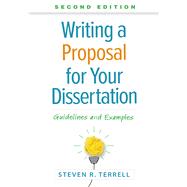Writing a Proposal for Your Dissertation Guidelines and Examples
, by Terrell, Steven R.- ISBN: 9781462550234 | 1462550231
- Cover: Paperback
- Copyright: 10/31/2022
The encouraging book that has guided thousands of students step by step through crafting a strong dissertation proposal is now in a thoroughly revised second edition. It includes new guidance for developing methodology-specific problem statements, an expanded discussion of the literature review, coverage of the four-chapter dissertation model, and more. Terrell demonstrates how to write each chapter of the proposal, including the problem statement, purpose statement, and research questions and hypotheses; literature review; and detailed plans for data collection and analysis. "Let's Start Writing" exercises serve as building blocks for drafting a complete proposal. Other user-friendly features include case-study examples from diverse disciplines, “Do You Understand?” checklists, and end-of-chapter practice tests with answers. Appendices present an exemplary proposal written three ways to demonstrate quantitative, qualitative, and mixed methods approaches, and discuss how to structure a four-chapter dissertation.
New to This Edition
*Introduction offering a concise overview of the entire proposal-writing process and the doctoral experience.
*Additional help with tailoring problem and purpose statements for quantitative, qualitative, and mixed-methods studies.
*Expanded discussion of the review of literature, including a criterion for judging the quality of primary versus secondary sources.
*Many new examples from different disciplines, such as studies of depression treatments, approaches to reducing offender recidivism, health effects of irradiated crops, strength training in college football, and remote teaching and learning during COVID-19.
*Focus on the five-chapter model is broadened to include specific guidance for four-chapter dissertations.
*Broader, more detailed reference list and glossary.
New to This Edition
*Introduction offering a concise overview of the entire proposal-writing process and the doctoral experience.
*Additional help with tailoring problem and purpose statements for quantitative, qualitative, and mixed-methods studies.
*Expanded discussion of the review of literature, including a criterion for judging the quality of primary versus secondary sources.
*Many new examples from different disciplines, such as studies of depression treatments, approaches to reducing offender recidivism, health effects of irradiated crops, strength training in college football, and remote teaching and learning during COVID-19.
*Focus on the five-chapter model is broadened to include specific guidance for four-chapter dissertations.
*Broader, more detailed reference list and glossary.







